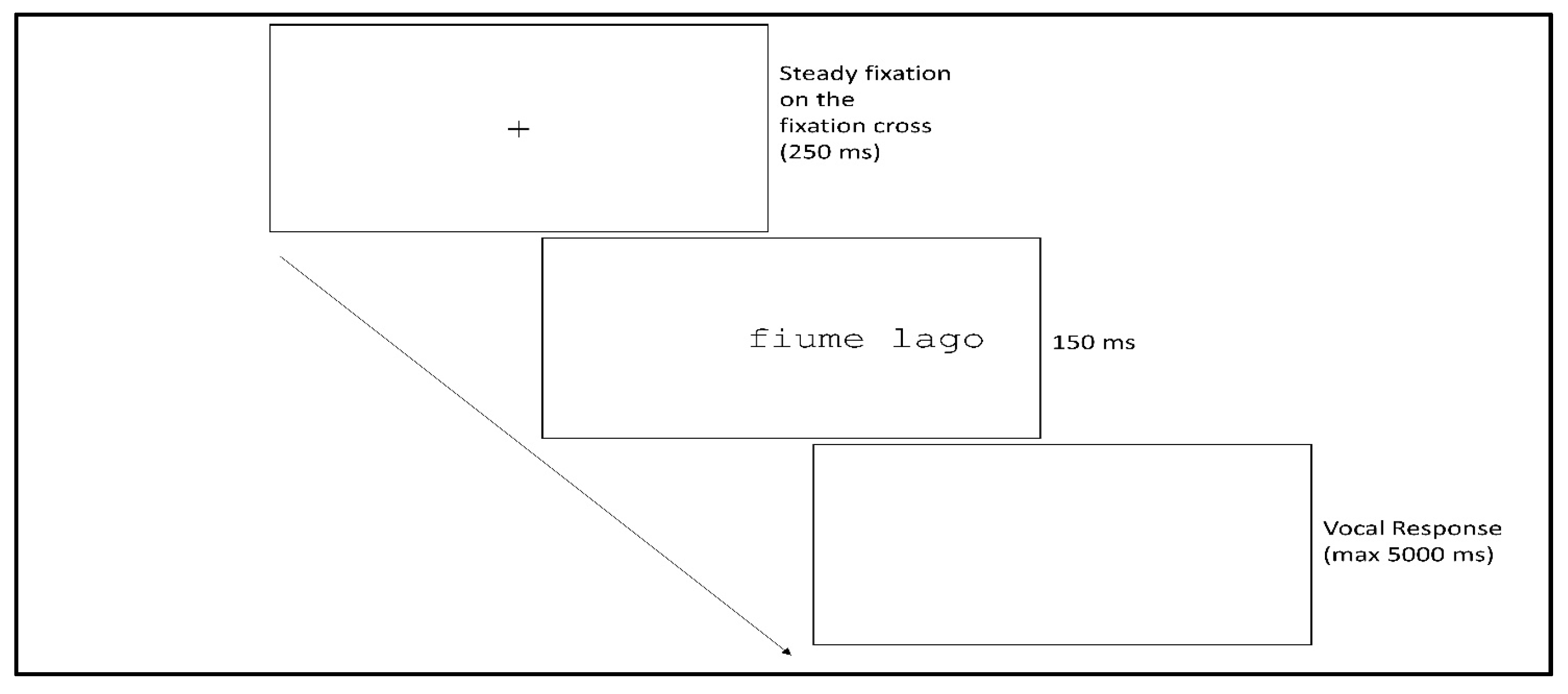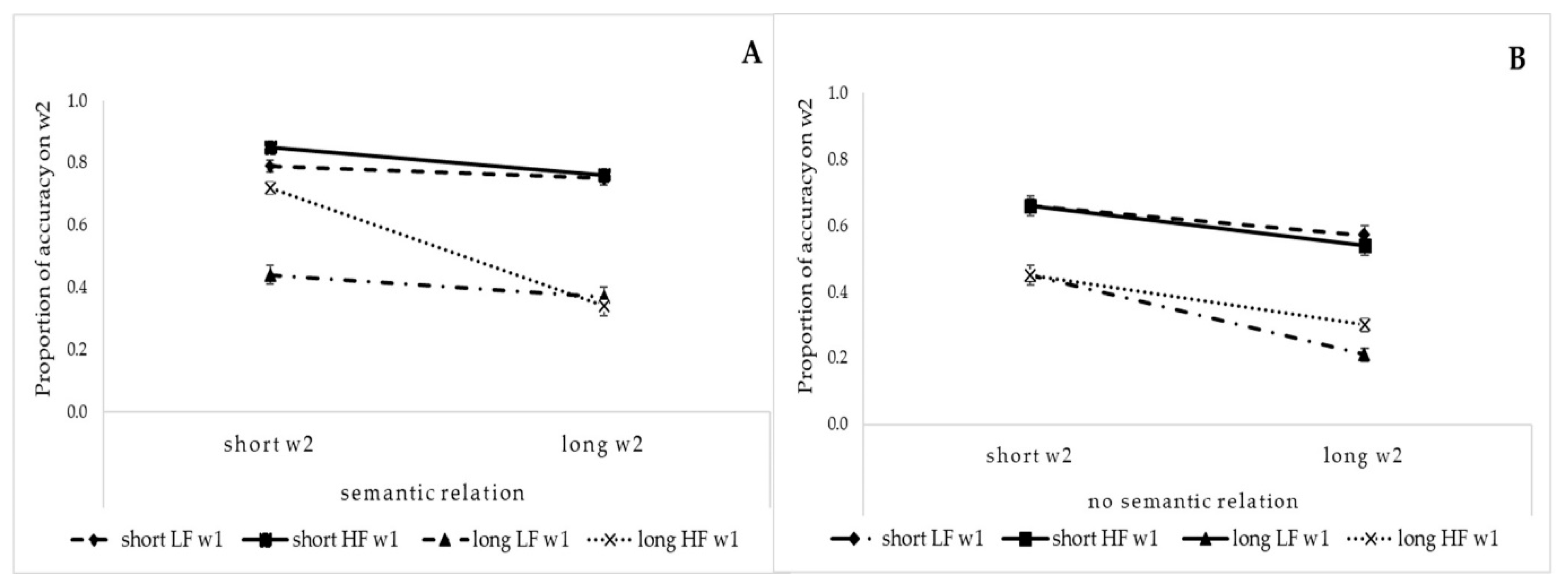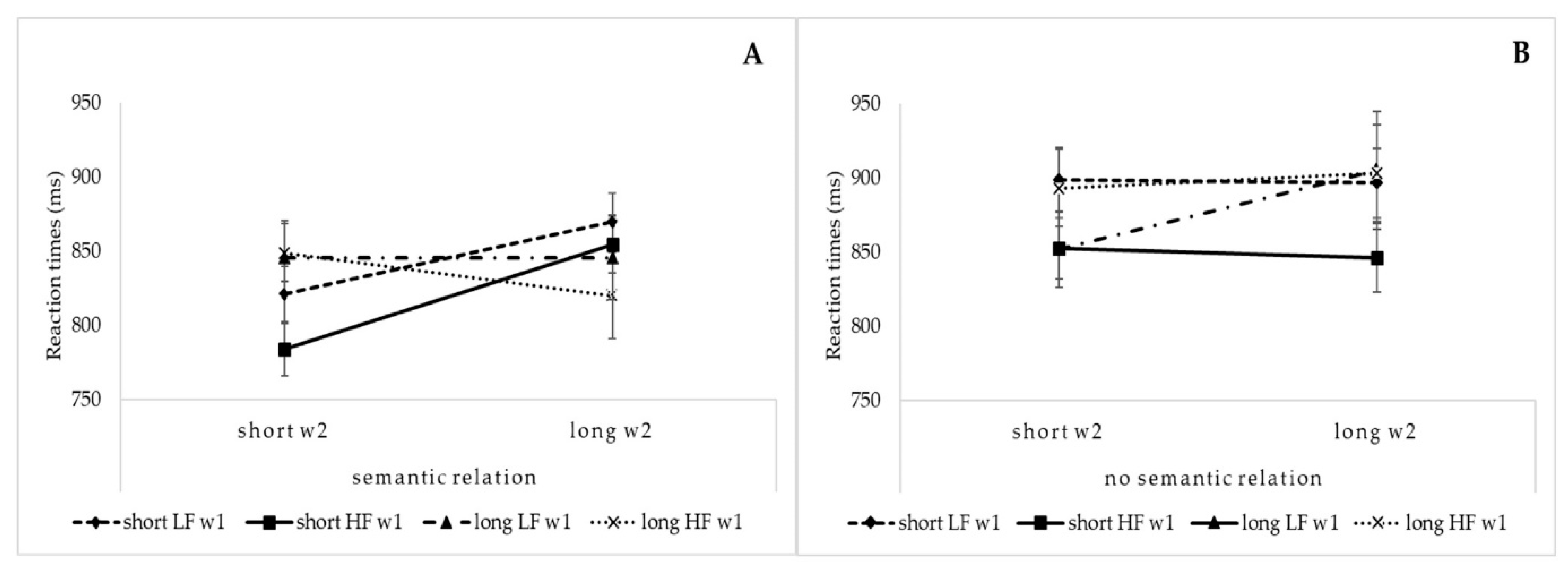Evidence of Semantic Processing in Parafoveal Reading: A Rapid Parallel Visual Presentation (Rpvp) Study
Abstract
1. Introduction
2. Materials and Methods
2.1. Participants
2.2. Stimuli
2.3. Software and Apparatus
2.4. Experimental Procedure
3. Results
3.1. Accuracy
3.2. Reaction Times
3.3. Qualitative Errors Analysis
4. Discussion
5. Conclusions
Author Contributions
Funding
Institutional Review Board Statement
Data Availability Statement
Conflicts of Interest
References
- Rayner, K.; Reichle, E.D.; Pollatsek, A. Eye movement control in reading: An overview and model. In Eye Guidance in Reading and Scene Perception; Elsevier: Amsterdam, The Netherlands, 1998; pp. 243–268. [Google Scholar]
- Pelli, D.G.; Tillman, K.A.; Freeman, J.; Su, M.; Berger, T.D.; Majaj, N.J. Crowding and Eccentricity Determine Reading Rate. J. Vis. 2007, 7, 20. [Google Scholar] [CrossRef] [PubMed]
- Legge, G.E.; Mansfield, J.S. The visual span for reading decreases in peripheral vision. Investig. Ophthalmol. Vis. Sci. 1997, 38, S223. [Google Scholar]
- Miellet, S.; O’Donnell, P.J.; Sereno, S.C. Parafoveal Magnification: Visual Acuity Does Not Modulate the Perceptual Span in Reading. Psychol. Sci. 2009, 20, 721–728. [Google Scholar] [CrossRef] [PubMed]
- Rayner, K. The 35th Sir Frederick Bartlett Lecture: Eye movements and attention in reading, scene perception, and visual search. Q. J. Exp. Psychol. 2009, 62, 1457–1506. [Google Scholar] [CrossRef]
- Rayner, K. The perceptual span and peripheral cues in reading. Cogn. Psychol. 1975, 7, 65–81. [Google Scholar] [CrossRef]
- Schotter, E.R.; Angele, B.; Rayner, K. Parafoveal processing in reading. Atten. Percept. Psychophys. 2012, 74, 5–35. [Google Scholar] [CrossRef]
- Inhoff, A.W.; Rayner, K. Parafoveal word processing during eye fixations in reading: Effects of word frequency. Percept. Psychophys. 1986, 40, 431–439. [Google Scholar] [CrossRef]
- Kennedy, A.; Pynte, J.; Ducrot, S. Parafoveal-on-foveal interactions in word recognition. Q. J. Exp. Psychol. Sect. A 2002, 55, 1307–1337. [Google Scholar] [CrossRef]
- Rayner, K.; Balota, D.A.; Pollatsek, A. Against parafoveal semantic preprocessing during eye fixations in reading. Can. J. Psychol./Rev. Can. Psychol. 1986, 40, 473–483. [Google Scholar] [CrossRef]
- Rayner, K.; Schotter, E.R.; Drieghe, D. Lack of semantic parafoveal preview benefit in reading revisited. Psychon. Bull. Rev. 2014, 21, 1067–1072. [Google Scholar] [CrossRef]
- Hohenstein, S.; Kliegl, R. Semantic preview benefit during reading. J. Exp. Psychol. Learn. Mem. Cogn. 2014, 40, 166–190. [Google Scholar] [CrossRef]
- Schotter, E.R. Synonyms provide semantic preview benefit in English. J. Mem. Lang. 2013, 69, 619–633. [Google Scholar] [CrossRef]
- Schotter, E.R.; Lee, M.; Reiderman, M.; Rayner, K. The effect of contextual constraint on parafoveal processing in reading. J. Mem. Lang. 2015, 83, 118–139. [Google Scholar] [CrossRef]
- Schotter, E.R.; Jia, A. Semantic and plausibility preview benefit effects in English: Evidence from eye movements. J. Exp. Psychol. Learn. Mem. Cogn. 2016, 42, 1839–1866. [Google Scholar] [CrossRef]
- Veldre, A.; Andrews, S. Is semantic preview benefit due to relatedness or plausibility? J. Exp. Psychol. Hum. Percept. Perform. 2016, 42, 939–952. [Google Scholar] [CrossRef]
- Andrews, S.; Veldre, A. What is the most plausible account of the role of parafoveal processing in reading? Lang. Linguist. Compass 2019, 13, e12344. [Google Scholar] [CrossRef]
- Inhoff, A.W.; Radach, R.; Starr, M.; Greenberg, S. Allocation of Visuo-Spatial Attention and Saccade Programming during Reading. In Reading as a Perceptual Process; Elsevier: Amsterdam, The Netherlands, 2000; pp. 221–246. [Google Scholar]
- Kennedy, A.; Pynte, J. Parafoveal-on-foveal effects in normal reading. Vis. Res. 2005, 45, 153–168. [Google Scholar] [CrossRef]
- Pynte, J.; Kennedy, A. An influence over eye movements in reading exerted from beyond the level of the word: Evidence from reading English and French. Vis. Res. 2006, 46, 3786–3801. [Google Scholar] [CrossRef]
- White, S.J. Eye movement control during reading: Effects of word frequency and orthographic familiarity. J. Exp. Psychol. Hum. Percept. Perform. 2008, 34, 205–223. [Google Scholar] [CrossRef]
- Hyönä, J. Foveal and Parafoveal Processing during Reading. In Oxford Handbook on Eye Movements; Liversedge, S.P., Gilchrist, I.D., Everling, S., Eds.; Oxford University Press: Oxford, UK, 2011; pp. 819–838. [Google Scholar]
- Angele, B.; Tran, R.; Rayner, K. Parafoveal–foveal overlap can facilitate ongoing word identification during reading: Evidence from eye movements. J. Exp. Psychol. Hum. Percept. Perform. 2013, 39, 526–538. [Google Scholar] [CrossRef]
- Dare, N.; Shillcock, R. Serial and parallel processing in reading: Investigating the effects of parafoveal orthographic information on nonisolated word recognition. Q. J. Exp. Psychol. 2013, 66, 487–504. [Google Scholar] [CrossRef] [PubMed]
- Grainger, J.; Mathôt, S.; Vitu, F. Tests of a model of multi-word reading: Effects of parafoveal flanking letters on foveal word recognition. Acta Psychol. 2014, 146, 35–40. [Google Scholar] [CrossRef] [PubMed]
- Snell, J.; Vitu, F.; Grainger, J. Integration of Parafoveal Orthographic Information during Foveal Word Reading: Beyond the sub-lexical level? Q. J. Exp. Psychol. 2017, 70, 1984–1996. [Google Scholar] [CrossRef] [PubMed]
- Snell, J.; Mathôt, S.; Mirault, J.; Grainger, J. Parallel graded attention in reading: A pupillometric study. Sci. Rep. 2018, 8, 3743. [Google Scholar] [CrossRef] [PubMed]
- Drieghe, D. Parafoveal-on-foveal effects in eye movements during reading. In Oxford Handbook on Eye Movement; Liversedge, S.P., Gilchrist, I.D., Everling, S., Eds.; Oxford University Press: Oxford, UK, 2011; pp. 819–838. [Google Scholar]
- McConkie, G.W.; Rayner, K. The span of the effective stimulus during a fixation in reading. Percept. Psychophys. 1975, 17, 578–586. [Google Scholar] [CrossRef]
- Altarriba, J.; Kambe, G.; Pollatsek, A.; Rayner, K. Semantic codes are not used in integrating information across eye fixations in reading: Evidence from fluent Spanish-English bilinguals. Percept. Psychophys. 2001, 63, 875–890. [Google Scholar] [CrossRef]
- Balota, D.A.; Pollatsek, A.; Rayner, K. The interaction of contextual constraints and parafoveal visual information in reading. Cogn. Psychol. 1985, 17, 364–390. [Google Scholar] [CrossRef]
- Hyona, J.; Haikio, T. Is Emotional Content Obtained from Parafoveal Words during Reading? An Eye Movement Analysis. Scand. J. Psychol. 2005, 46, 475–483. [Google Scholar] [CrossRef]
- Engbert, R.; Kliegl, R. Parallel graded attention models of reading. In The Oxford Handbook of Eye Movements; Liversedge, S.P., Gilchrist, I.D., Everling, S., Eds.; Oxford University Press: Oxford, UK, 2011; pp. 787–800. [Google Scholar]
- Yan, M.; Richter, E.M.; Shu, H.; Kliegl, R. Readers of Chinese extract semantic information from parafoveal words. Psychon. Bull. Rev. 2009, 16, 561–566. [Google Scholar] [CrossRef]
- Yang, J. Preview effects of plausibility and character order in reading Chinese transposed words: Evidence from eye movements. J. Res. Read. 2013, 36, S18–S34. [Google Scholar] [CrossRef]
- Yang, J.; Wang, S.; Tong, X.; Rayner, K. Semantic and plausibility effects on preview benefit during eye fixations in Chinese reading. Read. Writ. 2012, 25, 1031–1052. [Google Scholar] [CrossRef] [PubMed]
- Schotter, E.R.; Reichle, E.D.; Rayner, K. Rethinking parafoveal processing in reading: Serial-attention models can explain semantic preview benefit and N+ 2 preview effects. Vis. Cogn. 2014, 22, 309–333. [Google Scholar] [CrossRef]
- Snell, J.; Declerck, M.; Grainger, J. Parallel semantic processing in reading revisited: Effects of translation equivalents in bilingual readers. Lang. Cogn. Neurosci. 2018, 33, 563–574. [Google Scholar] [CrossRef]
- Barca, L.; Burani, C.; Arduino, L.S. Word naming times and psycholinguistic norms for Italian nouns. Behav. Res. Methods Instrum. Comput. 2002, 34, 424–434. [Google Scholar] [CrossRef]
- White, S.J.; Bertram, R.; Hyönä, J. Semantic Processing of Previews within Compound Words. J. Exp. Psychol. Learn. Mem. Cogn. 2008, 34, 988–993. [Google Scholar] [CrossRef]
- Snell, J.; Van Leipsig, S.; Grainger, J.; Meeter, M. OB1-reader: A model of word recognition and eye movements in text reading. Psychol. Rev. 2018, 125, 969–984. [Google Scholar] [CrossRef]
- Grainger, J.; Van Heuven, W.J.B. Modeling Letter Position Coding in Printed Word Perception. In Mental Lexicon: Some Words to Talk about Words; Bonin, P., Ed.; Nova Science Publisher: Hauppauge, NY, USA, 2004; pp. 1–23. [Google Scholar]
- Engbert, R.; Nuthmann, A.; Richter, E.M.; Kliegl, R. SWIFT: A Dynamical Model of Saccade Generation during Reading. Psychol. Rev. 2005, 112, 777–813. [Google Scholar] [CrossRef]
- Snell, J.; Grainger, J. Readers Are Parallel Processors. Trends Cogn. Sci. 2019, 23, 537–546. [Google Scholar] [CrossRef]
- Snell, J.; Grainger, J. Consciousness Is Not Key in the Serial-versus-Parallel Debate. Trends Cogn. Sci. 2019, 23, 814–815. [Google Scholar] [CrossRef]
- Wen, Y.; Snell, J.; Grainger, J. Parallel, cascaded, interactive processing of words during sentence reading. Cognition 2019, 189, 221–226. [Google Scholar] [CrossRef]
- Schotter, E.R.; von der Malsburg, T.; Leinenger, M. Forced fixations, trans-saccadic integration, and word recognition: Evidence for a hybrid mechanism of saccade triggering in reading. J. Exp. Psychol. Learn. Mem. Cogn. 2019, 45, 677–688. [Google Scholar] [CrossRef]
- Reichle, E.D.; Warren, T.; McConnell, K. Using E-Z Reader to model the effects of higher level language processing on eye movements during reading. Psychon. Bull. Rev. 2009, 16, 1–21. [Google Scholar] [CrossRef]



| Semantically Related (SR) | Semantically Unrelated (SU) | |||
|---|---|---|---|---|
| w1 Mean (SD) | w2 Mean (SD) | w1 Mean (SD) | w2 Mean (SD) | |
| Short high-frequency words (N = 32) | length = 4.63 (0.50) | length = 4.63 (0.50) | length = 4.50 (0.52) | length = 4.38 (0.50) |
| frequency = 2.47 (0.3) | frequency = 2.30 (0.4) | frequency = 2.40 (0.4) | frequency = 2.36 (0.4) | |
| Short low-frequency words (N = 32) | length = 4.69 (0.47) | length = 4.63 (0.50) | length = 4.56 (0.51) | length = 4.50 (0.52) |
| frequency = 0.89 (0.2) | frequency = 1.33 (0.6) | frequency = 0.98 (0.22) | frequency = 1.21 (0.5) | |
| Long high-frequency words (N = 32) | length = 7.75 (0.86) | length = 7.88 (0.81) | length = 7.63 (0.72) | length = 7.94 (0.68) |
| frequency = 2.02 (0.2) | frequency = 2.03 (0.2) | frequency = 2.07 (0.1) | frequency = 2.05 (0.2) | |
| Long low-frequency words (N = 32) | length = 8.00 (0.82) | length = 7.63 (0.81) | length = 8.25 (0.77) | length = 7.81 (0.83) |
| frequency = 0.87 (0.3) | frequency = 0.90 (0.3) | frequency = 0.77 (0.3) | frequency = 0.86 (0.3) | |
| No Responses | Wilcoxon Test | Misread Words | Wilcoxon Test | ||
|---|---|---|---|---|---|
| short w2 | long w2 | short w2 | long w2 | ||
| 33.8% (N = 372) | 66.2% (N = 729) | Z = 465; p < 0.001 | 60% (N = 282) | 40% (N = 188) | Z = 40; p < 0.0001 |
| low frequency w2 | high frequency w2 | low frequency w2 | high frequency w2 | ||
| 52.5% (N = 578) | 47.5% (N = 523) | Z = 108; p = 0.052 | 49.6% (N = 233) | 50.4% (N = 237) | Z = 146; p = 0.9 |
| semantically related | semantically unrelated | semantically related | semantically unrelated | ||
| 42.1% (N = 464) | 57.9% (N = 637) | Z = 40; p > 0.0001 | 42.8% (N = 201) | 57.2% (N = 269) | Z = 50.5; p = 0.001 |
Publisher’s Note: MDPI stays neutral with regard to jurisdictional claims in published maps and institutional affiliations. |
© 2020 by the authors. Licensee MDPI, Basel, Switzerland. This article is an open access article distributed under the terms and conditions of the Creative Commons Attribution (CC BY) license (http://creativecommons.org/licenses/by/4.0/).
Share and Cite
Rusich, D.; Arduino, L.S.; Mauti, M.; Martelli, M.; Primativo, S. Evidence of Semantic Processing in Parafoveal Reading: A Rapid Parallel Visual Presentation (Rpvp) Study. Brain Sci. 2021, 11, 28. https://doi.org/10.3390/brainsci11010028
Rusich D, Arduino LS, Mauti M, Martelli M, Primativo S. Evidence of Semantic Processing in Parafoveal Reading: A Rapid Parallel Visual Presentation (Rpvp) Study. Brain Sciences. 2021; 11(1):28. https://doi.org/10.3390/brainsci11010028
Chicago/Turabian StyleRusich, Danila, Lisa S. Arduino, Marika Mauti, Marialuisa Martelli, and Silvia Primativo. 2021. "Evidence of Semantic Processing in Parafoveal Reading: A Rapid Parallel Visual Presentation (Rpvp) Study" Brain Sciences 11, no. 1: 28. https://doi.org/10.3390/brainsci11010028
APA StyleRusich, D., Arduino, L. S., Mauti, M., Martelli, M., & Primativo, S. (2021). Evidence of Semantic Processing in Parafoveal Reading: A Rapid Parallel Visual Presentation (Rpvp) Study. Brain Sciences, 11(1), 28. https://doi.org/10.3390/brainsci11010028





